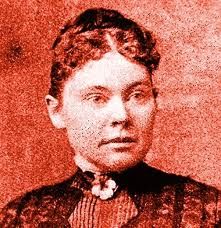Law and Crime
Ax Lizzie for the Tour
Unsolved double homicide still haunts Fall River
Posted August 3, 2012

On August 4, 1892, one hundred and twenty years ago, the hacked-up bodies of Andrew Borden, 70, and Abby Borden, 65, were discovered inside their home in Fall River, Massachusetts. Andrew's corpse lay on the living room couch, his face cut by eleven sharp blows. It appeared as though he was napping, except that one eye, sliced in half, was hanging out.
Andrew’s daughter, Lizzie, found him. She was 32, single, and living at home. The only other person in the house at the time was the maid, Bridget Sullivan.
Lizzie sent Bridget for help. When asked where she had been, Lizzie said she’d gone into the barn and had left the back door unlocked. The unspoken implication is that whoever had murdered her father must have come in that way.
A neighbor, Mrs. Churchill, arrived and asked Lizzie where her stepmother was. Lizzie recalled that Abby had gone visiting, but thought she had returned and gone upstairs. Would Mrs. Churchill please check? (Lizzie asked this, despite the fact that her father’s killer might still be there in the house.)
Mrs. Churchill got nearly to the landing of the second floor when she looked into the guestroom on her left and spotted a body slumped on the other side of the bed. Abby Borden had been slain with a sharp weapon, possibly a hatchet, inflicting upon her eighteen to twenty blows.
I’d always wondered how someone could have seen a body on the far side of the bed, and I had the chance to find out for myself when I heard that this infamous home at 92 Second Street had opened as a Bed & Breakfast, run by Martha McGinn.
With help from crime scene photos, the house had been made to resemble its condition on that August morning. The dining room furniture had actually been Lizzie’s. (Since then, it has changed hands, but they still have it fully furnished for guests and a subscription-only ghost cam).
Back to 1892: The police discovered that Abby Borden, lying face down on the floor, had been killed over an hour before Andrew. This meant that the murderer had been lurking in the house all this time. Yet there was no evidence that he’d tracked blood from one room to the next, washed himself in the guestroom basin, or hidden in the single narrow closet upstairs. The place was too small for him to have successfully escaped detection, especially if he were an out-of-control lunatic, as some surmised.
As investigators questioned Lizzie and Bridget, they learned that it was the family practice to keep all doors locked. Lizzie said she’d been in the barn for twenty minutes, although investigators found no evidence that the thick dust on the floor had been disturbed.
Due to inconsistencies in her story, Lizzie was arrested and tried, but she’d hired a crack defense team and the all-male jury was reluctant to find her guilty of a capital crime. She was acquitted. Lizzie Borden sold the murder house and used her inheritance to purchase a mansion in the wealthy area of town. When she eventually died, she was buried in the family plot.
Through the years the murder house was used as a rooming house, bookie joint, and Kewpie doll factory. Then in 1947 John and Josephine McGinn purchased it, signing the sales agreement on their wedding anniversary, August 4 – the anniversary of the murders. (In fact, Mr. McGinn died a few years later on July 19, Lizzie’s birthday.)
Tasked with gathering information for a modern-day behavioral profile, I’d read the investigation reports and trial records, and had discovered plenty of things that seemed to have been overlooked at the trial. For example, a bucket of bloodstained cloth in the basement was never fully examined. Bridget, who did the laundry, said it had not been there when she was in the basement the day before. Yet, Lizzie, who claimed it was from her menstrual cycle, said the bucket had been there for several days. (Clever girl - she knew that one way to deflect male investigators was to mention her period.)
Right here, I knew, could be the very evidence that Lizzie had done the deed, washed herself off, and stashed the bucket in the basement before she called Bridget down from her room. She’d had time during the few minutes between the discovery of her father's body and her call to Bridget, especially if she'd shielded herself with her father’s overcoat.
This expensive wool coat was found rolled and placed under Andrew's head, as if he'd used it as a pillow for his nap. Yet he was a parsimonious man who always hung his coat up in order to make it last for years. He’d hardly have rolled it on a hot and muggy day to place under his sweaty head.
But Lizzie might have. If we consider that she killed him, we can imagine the following scenario: Andrew comes home and hangs up his coat. Lizzie has murdered Abby and she prepares to murder Andrew. As he lies down, she grabs his coat, pulls it over herself, backwards, to protect her dress, and stands over Andrew, at his head, but protected behind the doorjamb that’s near the couch. She brings the ax down on him nine times, quickly, then removes and rolls the coat, placing it under his head to get soaked with his blood. Free of blood spatters herself, she calls the maid. (Or, perhaps she did get some blood on her face, so she washed it off and stashed these rags in a bucket in the basement while Bridget was running off the fetch the doctor.)
Lizzie handed over a dress to the police that she said she’d been wearing on the morning of the murders, but Mrs. Churchill, who had seen her, insisted she had lied. No one could locate the one she described, and a friend had seen her burn a dress in the kitchen stove.
This evidence implicates Lizzie, but she was never convicted. No one even examined the coat for blood pattern evidence, although they did know what this could mean, forensically, at the time.
Her motive? Money. Lizzie had overheard her father discuss giving Abby an investment that she had hoped to inherit. I’m convinced that Lizzie did it and that the forensic evidence available at the time had been ignored. No one ever addressed the discrepancy between Lizzie and Bridget’s story about the bloody rags in the bucket.




